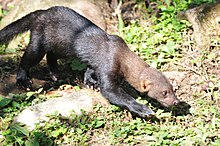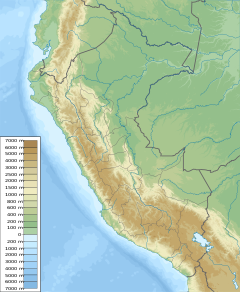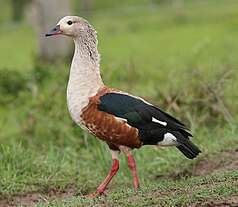Manú National Park
| Manú National Park | ||
|---|---|---|
| River bank in the Manú National Park | ||
|
|
||
| Location: | Cusco , Madre de Dios , Peru | |
| Surface: | 18812 km² | |
| Founding: | May 29, 1973 | |
| Orinocogans, one of the species found in the national park | ||
The Manú National Park ( Spanish Parque Nacional del Manu ) is a national park in the Amazon region in the southeast of Peru in the region of Madre de Dios and small parts in the Cusco region . It is located east of Cusco on the eastern slope of the Andes . The park was established in 1973, making it the third national park in the country and one of the oldest protected areas of this rank in the tropical rainforest, and it covers an area of 18,812 km². Its purpose is the preservation of the typical flora and fauna as well as the preservation of the way of life of the original inhabitants, the autochthonous Indians in this part of the Amazon forest. When it was founded, UNESCO declared the national park a biosphere reserve and, in 1987, a world natural heritage site .
Characteristics
Access to the national park is very limited. The core zone, which makes up 81.5 percent of the area, may not be entered. Small Indian tribes that do not want any contact with the outside world are excluded from this regulation. Another 13.5 percent of the area may only be entered with special permission for research and restricted tourism and serve as a buffer to the core zone. The remaining 5 percent are largely populated, although this part is mostly reserved for the indigenous people. Thanks to these extremely restrictive measures, the original flora and fauna of the national park were largely preserved.
There is an altitude difference of 4000 m between the eastern foothills of the Andes and the lowlands of the Amazon , giving the national park three different levels of vegetation : rainforest, mountain rainforest and high mountains . The diversity of flora and fauna is also the subject of research at the Cocha Cashu biological station, which has the largest database of tropical ecosystems in South America . The station is operated by the University of La Molina in cooperation with the Zoological Institute in Frankfurt am Main . The researchers estimate that around 10 percent of all plants found in the national park are still completely unknown to science. In the rainforest there are gigantic trees over 60 m high and 3 m in diameter, from which lianas and other tendrils hang down and prevent light from reaching the rainforest floor. In the mountain rainforest there are trees with twisted trunks, denser vegetation and a much higher biodiversity. Lichen , moss , ferns and a huge variety of orchids exist here . In the high mountains, the vegetation changes into a lighter forest landscape with the dwarf reed grass typical of the Andes . 550 previously unknown bird species, over 200 mammal species and over 100 bat species were registered in the three vegetation levels. Animals threatened with extinction, such as the black caiman or the giant otter , can still be found here in stable populations.
Mammals

Due to its size and the different vegetation zones, the park is home to numerous animal species, including around 200 mammals. The jaguar and the somewhat smaller puma represent the top predators of the area, with the puma rising from the lowlands to heights of over 3000 m and the jaguar usually staying below 1000 m. The greater heights above 1700 m are also the home of the spectacled bear . Smaller predators are represented in the lowland forests by ocelots , tayras , short-eared foxes , coatis , wrapped bears and giant otters, and in the higher areas by Andean jackals . The largest animals of the area are the tapirs . Other ungulates of the reserve are collared peccaries , Weißbartpekaris , spit deer and white-tailed deer . The swamp deer has also been identified. The toothed arms include the great anteater , the tamandua , the pygmy anteater , the giant armadillo , the nine-banded armadillo and two species of sloth. The most noticeable rodents include the capybara, the pakarana and the paka . A total of 14 different species of monkeys and numerous small mammals also enrich the fauna. Manu Biosphärenreservat, including the park, in particular, the following species of monkeys have been demonstrated: The Goeldi , the tiny Pygmy Marmoset , the Weißstirn capuchin (subspecies cuscinus ), the Gehaubte capuchin (subspecies peruanus ), the brown-mantled tamarin , the Emperor Tamarin , the Bolivian squirrel monkey , the Black-Headed Night monkey , the brown jumper monkey , the bald faced saki , the Bolivian howler monkey , the black- faced spider monkey and the gray woolly monkey . The mustache tamarin has also been detected on the northern border of the national park .
Avifauna
The Manú National Park has a very large avifauna due to its very different habitats. The species represented here include tangerines , toucans , tree climbers , hummingbirds , quetzals and real parrots . Some species have their main distribution area in the national park. These include the Schwarzkopf ornamental bird and the red-fronted ant thrush . The special species that occur in the national park also include the hoatzin , the orinocogans , the Andean cliff bird and the harpy . During the migration period, numerous bird species can also be found here, their breeding area is in North America. This includes in particular a large number of wood warblers . North American shorebirds also use the river banks to rest. The special spectacles include the large flocks of various macaws that visit certain cliffs and river banks in the lowland rainforest.
ethnicities
In the national park, small Indian tribes live in their natural environment. Some of these are known by their names, such as the Machiguengas , the Yora , the Yaminahuas , the Mashco-Piros and the Amahuacas . Only the Machiguengas and Yora have contact with the outside world and the park authorities. They live in tropical huts that are covered with palm leaves and are active as hunters and gatherers and cultivate small areas of cultivation. In the middle of the national park they contribute to the balance of nature. As was the case hundreds of years ago, their form of society is controlled by kinship rules and ancestral beliefs. They handcraft clothes out of cotton and make ceramic utensils and jewelry. They cultivate yuca , corn , papaya , pineapple and bananas in the small areas around the villages . They use arrows, spears and stone axes for hunting. The influence of modern society cannot be completely kept away and therefore some Indians are slowly trying to prepare their tribe for the change.
Paititi , the lost city of the Inca , is said to be in the national park. Many expeditions, most recently in 2002, have only found traces of the Inca and numerous petroglyphs . Due to the enormous amount of rubber there was a boom in the last century, in the course of which the city of Puerto Maldonado was created. After the boom subsided, many workers made their living selling jaguar skins , ocelot skins, and snake and crocodile skins . Today the city is the starting point for tours into the rainforest.
Threats
An important buffer zone of the national park, the Nahua-Nanti reserve, is endangered by Peru's largest natural gas project "Camisea". Blasting and other oil and gas work have already placed restrictions on flora and fauna there. Indigenous peoples are also threatened. A planned expansion of Camisea could create further restrictions for the national park as well. In addition, the Peruvian government is also reportedly considering oil and gas exploration in the national park itself, although the plans have so far been kept under wraps. Peruvian organizations of indigenous peoples and the human rights organization Survival International campaign against these projects and for the protection of the areas.
supporting documents
Individual evidence
- ^ Sergio Solari, Víctor Pacheco, Lucía Luna, Paul M. Velazco, and Bruce D. Patterson (2006). List of mammal species known to occur in Manu Biosphere Reserve, Peru. FIELDIANA: ZOOLOGY, NS, NO. 110, NOVEMBER 10, 2006, PP. 13–22 online PDF
- ↑ Victor Pacheco, Bruce D. Patterson, James, L. Patton, Louise H. Emmons, Sergio Solari, César F. Ascorra: List of mammal species known to occur in Manu Biosphere Reserve, Peru. Publicationes del Museo de Historia Natural. Serie a Zoologica 1993. Archived copy ( memento of the original from March 17, 2009 in the Internet Archive ) Info: The archive link was inserted automatically and has not yet been checked. Please check the original and archive link according to the instructions and then remove this notice. online PDF
- ^ Project Camisea
- ↑ Gas company targets protected Manú park in Peruvian Amazon
literature
- David Burnie (Ed.): Vögel , Munich 2008, Dorling Kindersley, ISBN 978-3-8310-1272-5
Web links
- World Database on Protected Areas - Manú National Park (English)
- Entry on the UNESCO World Heritage Center website ( English and French ).
- Tour operator for the Manú National Park




